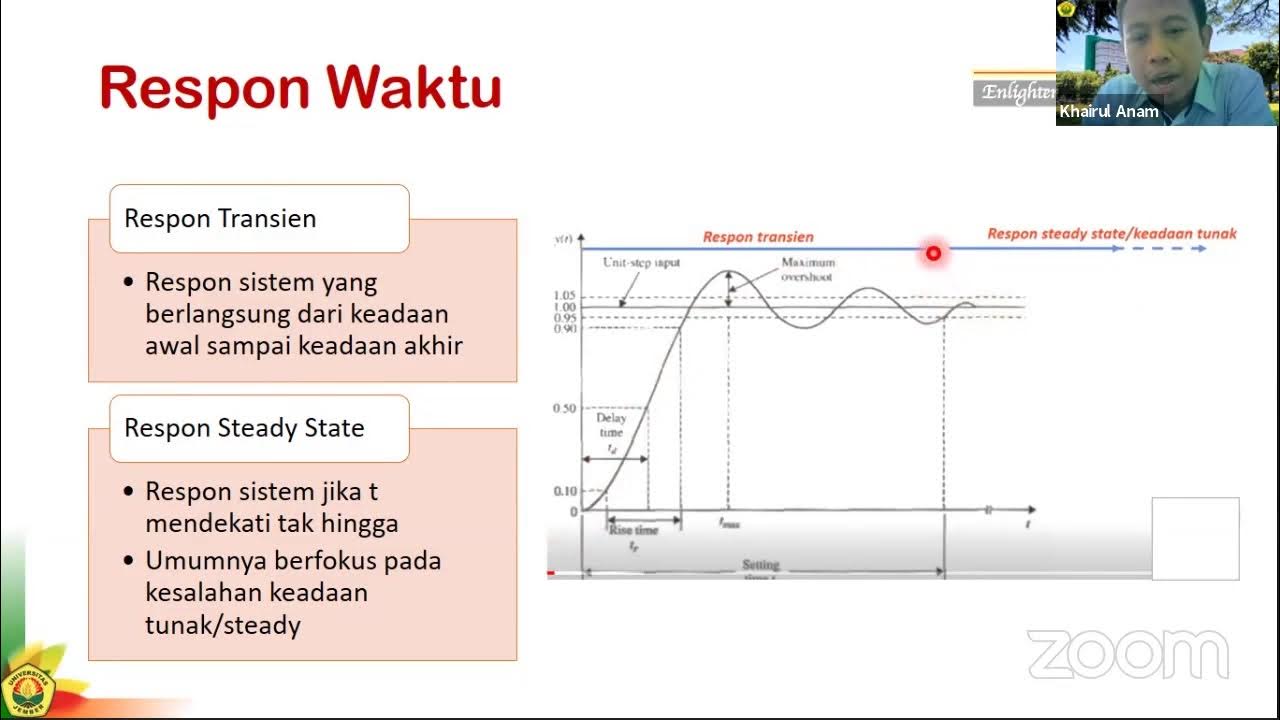System Response Characteristics
Summary
TLDRThis lecture on control systems explores system response characteristics, focusing on the differences between input and output responses. It highlights the concept of transient and steady-state responses using an elevator example. The lecture explains how the input is instantaneous, while the output is gradual due to the system's work. The transient response occurs during the work phase, and the steady-state response represents the final output. The accuracy of the system in the steady-state is also discussed, as well as the steady-state error. The lecture concludes with a preview of the next topic on system configurations, including open-loop and closed-loop systems.
Takeaways
- 😀 The lecture discusses the system response characteristics in control systems.
- 😀 The input to a control system is the desired response, while the output is the actual response produced by the system.
- 😀 The difference between the actual response and the desired response is known as the error of the control system.
- 😀 The system's response can be shown graphically to illustrate how output varies with respect to input.
- 😀 The example of an elevator is used to demonstrate how a control system works, with the elevator moving from the ground floor to the fourth floor.
- 😀 Input in a control system changes instantaneously, while the output is gradual due to the system performing tasks to generate the result.
- 😀 In control systems, output responses are typically different from the input due to the system's time-dependent processes.
- 😀 The elevator example introduces the concepts of transient and steady-state responses in control systems.
- 😀 The transient response lasts for a short interval, whereas the steady-state response represents the system's final output once equilibrium is reached.
- 😀 Steady-state error occurs when there is a difference between the desired and actual output at the steady state, as seen in the elevator's positioning accuracy.
- 😀 The lecture concludes by introducing the next topic: system configurations, specifically open-loop and closed-loop configurations, which will be explored in the following lecture.
Q & A
What is the main topic discussed in this lecture?
-The main topic of this lecture is the system response characteristics in control systems, including the factors that cause variation in output with respect to the input.
What did the previous lecture cover before this one?
-The previous lecture introduced control systems and discussed the block diagram of a control system, including the input, output, and error components.
What are the two factors that cause the output to differ from the input in a control system?
-The two factors are that the input changes instantaneously, but the output changes gradually. This is because control systems require time to process and generate the output.
How is the movement of an elevator used as an example in this lecture?
-The elevator example demonstrates how the input (pressing the button for the fourth floor) is an instantaneous command, while the output (the elevator moving to the fourth floor) occurs gradually over time.
What are the two versions of the elevator's response that are discussed?
-The first version represents the elevator's gradual movement from the ground floor to the fourth floor, known as the transient response. The second version represents the elevator being stationary at the fourth floor, known as the steady-state response.
What is meant by 'transient response' in a control system?
-The transient response refers to the period during which the control system is working to generate the output, and it lasts for a short interval of time before reaching the steady-state.
What is the 'steady-state response' of a control system?
-The steady-state response is the output of the control system once it has reached a stable condition and no longer changes, indicating the final output has been generated.
What is the error in the system during the steady-state, and what example is provided?
-The error in the steady-state refers to the difference between the desired output and the actual output. In the elevator example, the actual position of the elevator might be slightly below the fourth floor level, which causes a small steady-state error.
Why is it important to address steady-state errors in control systems?
-In many control systems, steady-state errors need to be minimized or eliminated to ensure accurate and reliable performance. Some systems accept these errors, while others require specific configurations to reduce them.
What will be discussed in the next lecture of the course?
-The next lecture will discuss system configurations, specifically the open-loop and closed-loop system configurations, and their impact on control system performance.
Outlines

This section is available to paid users only. Please upgrade to access this part.
Upgrade NowMindmap

This section is available to paid users only. Please upgrade to access this part.
Upgrade NowKeywords

This section is available to paid users only. Please upgrade to access this part.
Upgrade NowHighlights

This section is available to paid users only. Please upgrade to access this part.
Upgrade NowTranscripts

This section is available to paid users only. Please upgrade to access this part.
Upgrade NowBrowse More Related Video

Overview of FIR and IIR Filters

#174 Time response of second order control systems || EC Academy

Illustration of sinusoidal transient and steady-state in time-response of LTI systems

Pertemuan 3. Sistem Kendali Pada Robot | Robotic and Control System

Sistem Kontrol #3b: Analisis Respon Waktu Sistem Orde 1

Sistem Kontrol #3a: Analisis Repon Sistem - Pendahuluan
5.0 / 5 (0 votes)